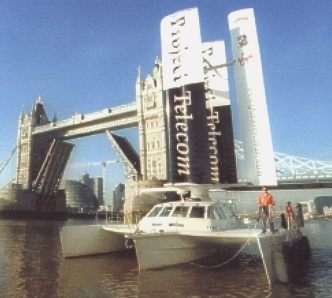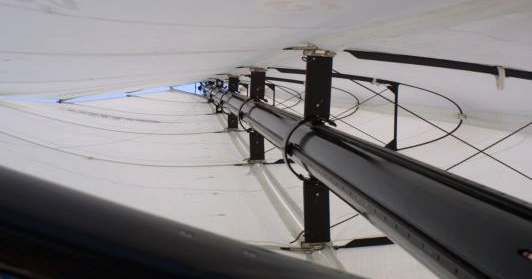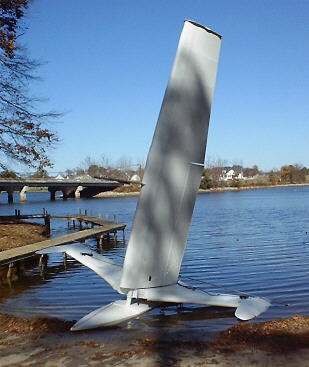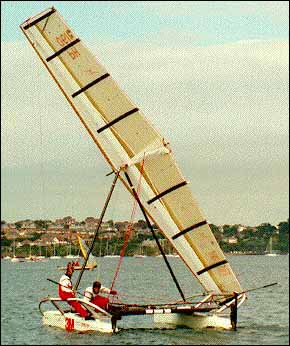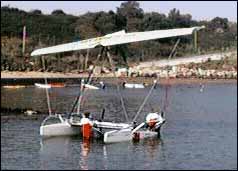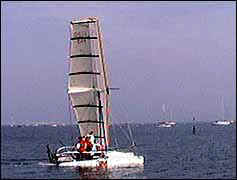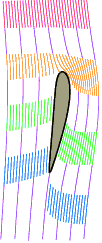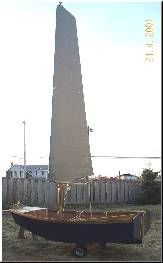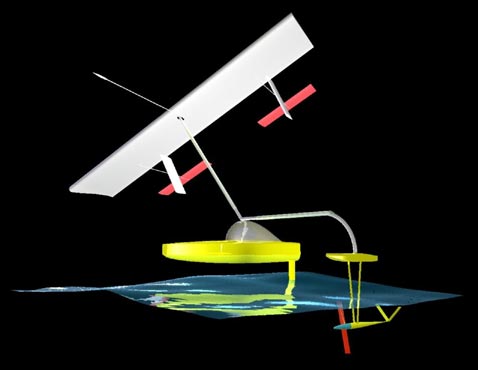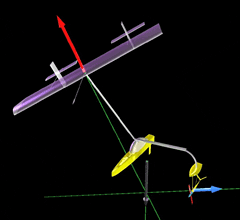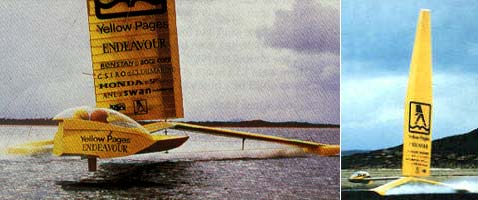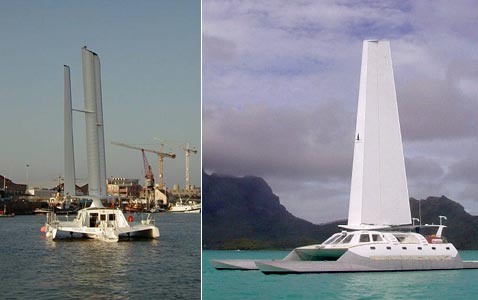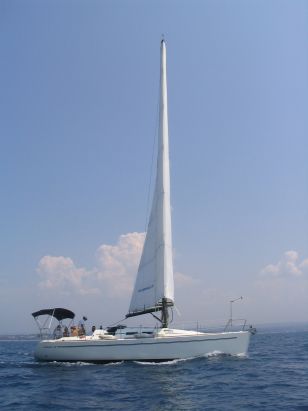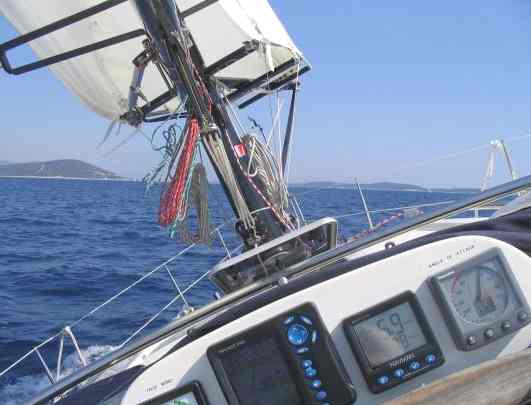|
WING SAILS
|
||||||||||||||||||||||||||
|
HOME | BIOLOGY | BOOKS | FILMS | GEOGRAPHY | HISTORY | INDEX | INVESTORS | MUSIC | NEWS | SOLAR BOATS | SPORT |
||||||||||||||||||||||||||
|
Wingsail History - A brief history of wingsail technology and its commercial applications.
Walker Wingsail
Walker Wingsail Systems plc built and sold an 8 tonne wingsail for use on MV Ashington in 1986. Collapse of world oil prices destroyed the economic case for use of wingsails in commercial shipping and the company turned to the luxury yacht markets and launched the trimaran design Blue Nova in 1990 and a smaller 43ft Zefyr trimaran design of which four were produced between 1997-2001.
These wingsail boats attract attention wherever they are seen. Inventure has been extensively modified to enable sailing by a paraplegic, with a heavily publicised story. The first three Zefyrs left the UK very soon after being sold. The fourth, Larinka, spent last winter in a very prominent berth at Portsmouth (Gun Wharf Quays) where she was a real eye-catcher.
Walker Wingsail trimaran
Both of the companies managed by the designer John Walker (Walker Wingsail Systems plc, 1982-98 and Wingtek plc, 1998-2000) failed and he remains subject to legal proceedings, though no charges have yet been upheld against him. An objective viewpoint, and the evidence supporting this, is thus not yet available to non-litigants. This account is based, with benefit of hindsight, upon the present knowledge of Anne Toms, an enthusiast for this technology and long-term supporter of both companies.
Public and Commercial Reaction
During the 1980s and 90s, the UK media seemed hostile to wingsails, with a infamous libel case against the publication iYachting World-i. Venture capital funding appeared inaccessible and no UK boat-builders came in with Walker as partners. Investment was provided by 6,500 individual shareholders, with £12.5M invested before voluntary liquidation of WWS. One outside view was that the project needed £15-20M to succeed; another that the management and hull design were inappropriate.
Wingtek plc, the successor company to WWS plc, also tried to rely upon individual shareholders. It purchased from the liquidator of WWS the three partially built boats and moulds along with a licence for the IPR, but was compulsorily wound up (May-Nov 1999) to prevent publication of a prospectus for public subscription. Unusually, a Company Voluntary Arrangement was established (Spring 2000) to enable the company to trade its way back to solvency. This CVA relied upon an up-front loan from the customer for the next boat whose money failed to materialise.
No other customers were forthcoming, and so the CVA failed in August 2000, just as Zefyr_004 had been launched. This boat was purchased from the liquidator by James Wright and finished by Ian Page, to the best of his ability, but technical expertise was by then not available to him for some aspects of the software and control systems.
Omer wing sail mast inside view
Why Wingsails Haven't Caught On So Far
No substantive technical criticisms of any sort are known of the wingsail designs. The reasons for failure include lack of firm customers, pursuit of the wrong market when oil prices and interest rates moved against wingsails, management mistakes, manufacturing processes being too long and forecasts being always far more optimistic than realities ever were.
The companies did not fail for lack of interest in the emerging technology, but for inability to bring it successfully to market.
The English Board of Trade provided £207,500 in financial assistance to Walker Wingsail Systems Ltd. of Hamble, Hampshire under the support for innovation scheme before 1988, prior to the company's move to Plymouth. Grants made to Walker Wingsail Systems Ltd. under the support for innovation scheme were monitored at each payment stage. The financial assistance was forthcoming under the enterprise initiative consultancy scheme.
Cooke Associates
Cooke Associates aims to achieve the technical characterisation of the existing wingsail and to solve the technical challenges of fitting it to a catamaran hull with full integration, control and manufacturing feasibility.
In 2001 a preliminary review and further study of wingsails was commissioned by Anne Toms. This was conducted by Alison Cooke, who managed the staff resources, using ex-employees of Walker Wingsail Systems plc (wingsail designers), Boatek (small wingsail designer), Plymouth Composite Construction (boat-builders), Ecocats Ltd (boat-builders), The Patent Office, academics and students at Cambridge University Engineering Department, and consultants.
Wingsails Today
Windrocket US wingsailer
Why a Wing? | What's it made of? | Is it trailerable? | Drawings and Specs
Construction photos | Contact Us | FAQ's | Ordering info | Boat Shows | Zero Tech
The makers of the Windrocket above claim: she is probably faster than any other production sailboat! In a good breeze, as fast as the fastest personal watercraft (i.e., Jet Skis, etc.). In other words, about a mile-a-minute.
Our calculations indicate that the boat, in its standard configuration, should sail at about 2.5 times wind speed in winds from about 8 to 16 mph. Yellow Pages Endeavour (the current speed record boat) has sailed at slightly higher boatspeed/windspeed ratios. The speed potential of any sailboat depends on two ratios (the higher the better for both): Fh/R (maximum tolerable heeling force / resistance) and L/D (aerodynamic lift/drag).
These ratios are quite similar for the two boats. On one of YPE's record runs, their top speed was 52 knots or 60 miles per hour. (The actual record is an average, rather than top, speed.) So we believe we are justified in calling the Windrocket 16 the "Mile-a-Minute Sailboat". But of course, only more time in the water will tell for sure.
Aeroskimmer Wingsail
Aeroskimmer under sail
Wing in horizontal position = no drive
Aeroskimmer reaching
Aerodynamics of Wingsails
The following is extracted from a report prepared as part of the work done by Cooke Associates on establishing the commercial viability of the wingsail. The bulk of this report necessarily remains confidential. If, however, you should have a commercial interest in the commercial development of wingsail technology, please contact Dr Jani Macari Pallis. Introduction
The Walker wingsail is a novel form of marine propulsion, expected to provide significant advantages over traditional, "soft" rigs. To do so, it needs a higher maximum lift coefficient and lift-to-drag ratio than such rigs. Current sailing knowledge suggests that wingsails do fulfil these requirements but that, at low wind speeds, their associated weight penalty can nullify their benefits.
This report describes a brief aerodynamic assessment of the Walker wingsail.
(Summary of Principal Conclusions)
This report has assessed the aerodynamic characteristics of the Walker wingsail via a general study of the literature (section 2), a comparison of Walker experimental data with soft rig results (section 3) and a numerical study of the Walker and Boatek wingsail sections. The main conclusions are:
It is clear that the performance of any given rig is strongly dependent on its detailed design. However, for the purposes of comparison between different types, a summary of the 'typical' aerodynamic performance characteristics quoted in this report is given in the table below, which assesses sail performance in terms of the maximum lift coefficient, CLmax, and the maximum value of the lift-to-drag ratio, max. L/D. The less reliable values are followed by a question mark.
The dinghy below is a Chinese Junk rig, but instead of one sail surface there are two on the same mast with the leading edges joined together. Technically, she is a wingsail with several variations of the design having been used all over the world. What is unique about this rig is that all of the running and standing rigging plus the mast is between the two sail surfaces so they don't interfere with air flow and you don't see the mess of rigging that is a nightmare to view.
News | How It Works | Materials & Costs | Construction | Sailing References | Links | Other Designs | Graphics | Message Board | Background Info
The rig was designed by a Chinese fisherman over 100 years ago. The major modifications the owner made to the rig were the following: increased the aspect ratio, changed the taper ratio. Some aspects of the construction and size of the parts were determined through trial and error since not every detail was available. The materials used are different too. Please use the links above to read the owners construction details.
Рекорд под парусом: крылатые лодки обгоняют ветер - 21 июля 2004
Xождение под парусом увлекательная наука. Непосвящённые с трудом представляют себе, как можно двигаться на паруснике против ветра. Изобретатели же придумали очередное чудо аппараты, способные только за счёт ветра разгоняться намного быстрее, чем бежит толкающий их же поток воздуха. Математик Стивен Боерн (Stephen Bourn) из организации оборонной науки и технологий (Defence Science and Technology Organisation DSTO) подразделения министерства обороны Австралии спроектировал лодку, с которой намерен побить мировой рекорд скорости для парусных судов.
В качестве паруса автор машины использовал поворачиваемое в разных плоскостях и наклоняемое крыло, которое должно обеспечить сразу два действия.
Когда поток ветра будет набегать на это крыло под строго рассчитанным углом, подъёмная сила разложится на составляющие, одна из которых будет вытаскивать лодку из воды, а вторая тянуть вперёд.
Наклоном крыла в разные стороны можно изменять направление движения судна.
Лодка Боерна на полном ходу. Пока в компьютере (исллюстрация с сайта dsto.defence.gov.au).
Kак и у обычных парусников, способных ходить под углом к ветру и даже против него (пусть не прямо, а по косой), важную роль здесь играет киль, а в случае с лодкой австралийца маленькое вертикальное подводное крыло или, скорее, нож.
Их, к слову, у лодки несколько они не столько помогают поднять корпус из воды (этим занято крыло-парус), а удерживают лодку на курсе. В идеале почти всё судно Боерна должно лететь над водой.
Взаимное расположение крыла, корпуса и подводных элементов выбрано так, что ни при каких условиях лодка не будет опрокидываться, в отличие от обычных парусников.
Aвстралийский математик рассчитал, что его машина будет иметь наилучшее соотношение веса и тяговых возможностей. Она будет легко ускоряться против ветра (под некоторым углом, конечно).
Более того, при попутном дуновении бога Эола разгоняться до скорости 30-50 узлов при скорости самого ветра в 15 узлов. То есть двигаться вдвое или даже втрое быстрее толкающего её потока воздуха!
Автор проекта уверен в правильности расчётов, а работоспособность схемы проверил на маленькой радиоуправляемой модели. Видеозапись испытаний можно найти на этой странице.
Схема сил, действующих на крылатую лодку (фото с сайта dsto.defence.gov.au).
Tеперь Боерн мечтает построить полноразмерный вариант своей лодки с размахом крыла 8 метров и побить на нём мировой рекорд скорости для парусных судов на воде (есть ещё сухопутные парусные машины).
Yellow Pages Endeavor мировой рекордсмен (фотографии с сайтов foxxaero.homestead.com и wingsail.neuralfuzz.com).
Oн составляет 46,52 узла (примерно 86 километров в час) на 500-метровом отрезке. Австралиец же намерен показать не менее 90 километров в час, а возможно и более 100 (54 узла).
Интересно, что рекорд скорости на воде под парусом был установлен (ещё в 1993 году) на аппарате Yellow Pages Endeavor, который также был оснащён парусом-крылом (только вертикальным), и который построил опять-таки австралиец Линдсэй Каннингем (Lindsay Cunningham).
Его иногда именуют волшебником известно немало его скоростных парусных машин, которые доказали способность Каннингема выжимать из ветра всё возможное.
И Линдсэй остаётся самым опасным соперником Боерна, ведь Каннингем уже построил Macquarie Innovation судно с парусом-крылом, которое пытается превзойти достижение своего предшественника.
Увы, в последнее время команде Каннингема не везёт с погодой. А тут ещё на пятки именитому инженеру наступает ещё одна команда, и снова австралийская.
Конструкторы Билл Рэйнер (Bill Rayner) и Клиф Беркер (Clif Barker) создали свой крылатый DingBat ещё в 1999 году.
Прогулочные катамараны с крыльями-парусами пока экзотика, но уже не единичная (фотографии с сайтов sealord6.com и antrimdesign.com)
Что интересно, концепция этой машины напоминает конструкцию Боерна с горизонтальным наклоняемым в стороны крылом. Но и "летучей мыши" высоты скорости пока не покорились. А значит, у Боерна есть время, чтобы догнать соперников.
Любопытно, что пока энтузиасты парусов строят экзотические аппараты для побития рекордов, другие инженеры выпускают на просторы морей вполне практичные яхты и катамараны с крыльями вместо традиционных парусов.
Необычные свойства крыла и сравнительно лёгкое управление придают таким яхтам массу привлекательных свойств.
Пусть они развивают не такие большие скорости, как спортивные машины, может быть, когда-нибудь появятся комфортные прогулочные катамараны, с лёгкостью обгоняющие сам ветер без использования двигателя?
Источник: Membrana.ru
Объявления по теме: надувные
лодки с
доставкой В
интернет-магазине
OZON: В
царстве
воды и
ветра.
Очерки и
картины
из жизни
и
истории
Земли Водомоторная
техника
в кредит
за 30 минут.
Доставка
по
Москве
бесплатно!
Разместите здесь ваше рекламное объявление за 0.06$!
Новости по теме:
4x
скоростной
резак DVD+R DL
от Logitec 14
июля 2004 Бытовой
DVD-рекордер
Philips HDRW720 с
жестким
диском 12
июля 2004 DVD+R
DL
рекордер
Buffalo DVM-D88FB 10
июля 2004 В
Венгрии
поставлен
рекорд
скорости
в EDGE-сетях 6
июля 2004 12x
скоростной
Super-Multi DVD
рекордер
Logitec LDR-HA125 2
июля 2004 Маршрутизатор
Cisco занесен
в Книгу
рекордов
Гиннесса
2 июля
2004 Внешний
и
внутренний
DVD+R DL
рекордер
от Buffalo 2
июля 2004 Первый
в мире
внешний
DVD±R/RW
рекордер
для Apple Macintosh 1
июля 2004 Внешний
многоформатный
DVD-рекордер
от Pixela 29
июня 2004 LF-P667C - тонкий, внешний DVD рекордер от Panasonic 29 июня 2004
Omer wing sail on Maya port side
Wingsail Science on the Web
Boatek of Felixstowe market a small wingsail boat for single-handed racing. The Cornish firm Ecocats Ltd build environmentally friendly catamarans, which can be fitted with wingsails. Wingsail Charters offer wingsail boats for hire in Portsmouth. Wingsails also offer advantages to disabled sailors.
LINKS
Wings
are aerodynamically more efficient than sails. They provide the boat
with more lift (Driving Force) while inducing much less drag (Heeling
Force), and at the same time, the wing's small Angle of Attack gives
Excellent Upwind Performance.
Maya sailing boat equipped with Omer wing sail upwind
OMER
Wing Sail LTD. Tel:
+972-3-5401675 Email: ilan@omerwingsail.com
The Solar Navigator - SWASSH (Small Waterplane Area Stabilized Single Hull) test model 2012 The latest Solarnavigator is designed to be capable of an autonomous world navigation set for an attempt in 2015 if all goes according to schedule.
|
||||||||||||||||||||||||||
|
This website is Copyright © 1999 & 2013 Max Energy Limited, an environmental educational charity working hard for world peace. The names Solar Navigator,Blueplanet Ecostar BE3 and Utopia Tristar are trademarks. All other trademarks are hereby acknowledged. |
||||||||||||||||||||||||||
|
AUTOMOTIVE | BLUEPLANET | ELECTRIC CARS | ELECTRIC CYCLES | SOLAR CARS | SOLARNAVIGATOR |
